Update 2020-06-18: I now have a dedicated Weird Game-making Tools list and linkpage
I am outing myself as a videogame zineseter, a term coined by Anna Anthropy in her inspiring 2012 book Rise of the Videogame Zinesters. The book is equal parts manifesto and practical getting-started handbook. Around the time it came out I was playing lots of very strange and experimental DIY games, blogging about them, and curating exhibits (and leading workshops) dedicated to these games in a format that I co-curated with my friend Sarah Brin. We called this Punk Arcade (note: this links to our old Tumblr page), and delving deep into these games brought me to places much different than I had experienced in other areas of the arts, particularly in museums and galleries. I identified with Anna’s premise, that games are a form of accessible self-expression and that like early DIY punk bands and copy-and-paste zines, a new crop of accessible tools made game-making a potentially more diverse medium.
In Anna’s next book ZZT, published in 2014, she writes about her experience growing up and playing ZZT and its easy-to-use level/game design engine and the worlds created by amateur, independent game-makers. I started creating my own games this year as well, with lots of tools and engines, from no-code to full-on scripting, and made lots of short punky game-jam style games (especially as a resident at Babycastles in New York and as a participant in the online community Glorious Trainwrecks. In the past few years I continued to make art and games, with my UCLA thesis project, Messlife being a new hybrid form of art-game-gallery-space.
Although I now am able to make games in Unity and other scripting languages, I still enjoy both the spirit of simple game-making tools and the diversity of voices and approaches these tools have allowed to flourish. What follows is a roundup of several game-making tools selected for their ease-of-use, supportive community of users/players, and their ability to serve narrative creation (as opposed to fighting games per se). This list I’ve selected Spring 2018 and is not comprehensive. Anna’s book Make Your Own Videogames is due to come out on No Starch Press this year, so if you’re reading after winter/spring 2018 you may want to check for that. I particularly would like to point out Rylie James Thomas’s Gamemaking Tools Wiki as a go-to source as well. Enjoy.
The following tools are listed in order of complexity.
Kooltool

Kooltool is a super fun 2D online drawing tool for making adventure-style games by Mark Wonnacott. Simply draw some tiles and add some characters and text and click to publish to the web. Very simple concept and MSPaint aesthetics.
Bitsy
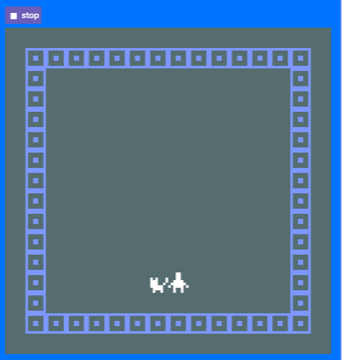
Bitsy, by Adam LeDoux, is similar to Kooltool with a bit more features for making a 2D browser-based game. Its goal is to be “easy to make games where you can walk around and talk to people and be somewhere.”
It’s easy to get started because it has simple constraints: limited color palette, tiny pixel canvas, simple game mechanics. No coding required. It’s good for short narrative games and tiny adventures.
- Main website
- Bitsy Tutorial
- a curated selection of Bitsy games
- a collection of re-usable scripts to extend Bitsy games
- even more Bitsy games
- excellent article on Rock Paper Shotgun about the Bitsy game-making community
Twine
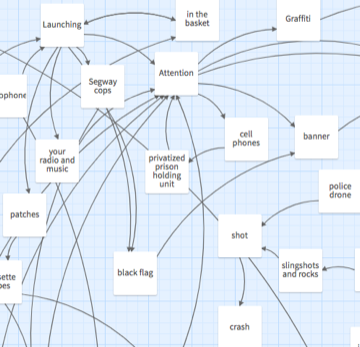
Twine is a great starting point if you’ve never made a game before. It has a huge community of players/game-makers and has good documentation and a large number of tutorials. Twine was created by Chris Klimas and there are downloadable and web-based versions you can use. Twine is primarily used to create experimental choose-your-own-adventure style games. Porpentine Charity Heartscape’s With Those We Love Alive was included in the 2016 Whitney Biennial.
- official website
- Anna Anthropy’s Twine introduction
- Twine, the Video-Game Technology for All in the NYTimes
- Twine wiki
- Games tagged Twine on itch
Tinychoice
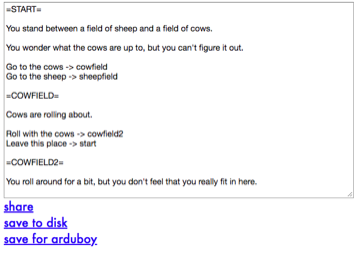
Tinychoice is another tool for making text adventure games. It’s even simpler! You write everything in an ultra simple markup language, then render it into a HTML page. It’s by Stephen Increpare Lavelle.
- official website
- I used it for making a text adventure version of a solo exhibit
- It’s written in Tinyscript
Vertex Meadow

Vertex Meadow, by Ian MacLarty, is a tool that takes 2d images and translates them into 3d terrain that you can walk through. It runs in a browser and is nice and glitchy.
- official website and gallery page
Scratch / Stencyl

These are drag-and-drop code blocks tools. Scratch, by MIT Media Lab is a general purpose language for kids to learn coding. You can make lots of things, including games. Stencyl is based on Scratch but has enough features to make fairly complex 2D videogames and publish them as apps or websites. Stencyl is often used to make platformer (Mario-style) games. It is free to use commercial software; you must pay for a license if you want to distribute your game as an app. It’s free to publish to the web however.
Puzzlescript and Dungeonscript
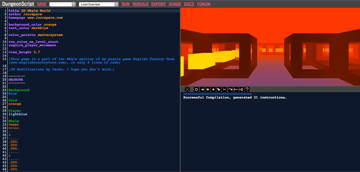
This is a web-based puzzle adventure game engine for making top-down 2d pixel-style games, like in a simplified Legend of Zelda style though of course not limited to that. Puzzlescript is by Stephen Increpare Lavelle and features a web-based editor that uses ASCII text to define the world, rules for characters and player movement, colors, sound, and an easy way to host the games and remix them online.
- official website
- Tutorial and Documentation
- A gallery of selected Puzzlescript games chosen by Increpare
- Dungeonscript is a fork of Puzzlescript and runs these games in first person 3D perspective!
Pico8
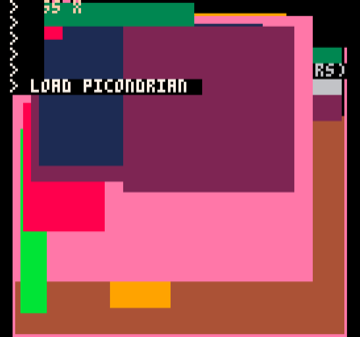
Pico8 is a fantasy console that runs in the browser and as desktop apps or on Raspberry Pi and similar Linux single board computers. It is purposely built with constraints and uses a simplified version of the Lua language. Pico8 includes a simplified Terminal, level editor, sprite creator, sound and soundtrack maker. Games (called Carts) are free to play online, but Pico8’s downloadable application (which allows you to make games) costs $15 or less when on sale.
- Pico8 website
- Updated carts page
- Beginner-friendly game-making Pico8 zines
- Pico8: The Basics
- PocketCHIP Play Pico8
P5Play

P5Play is a Javascript library to be used in conjunction with P5JS, the Javascript library for creative coding, especially aimed at beginners, artists and educators, based on the original ideas of Processing but brought to the web. P5JS is great for drawing to a canvas in a web browser with code, and P5Play extends this by providing support for animations, sprites, collision detection, key detection and other useful features you’d likely want for making a game. You will definitely want a bit of Javascript experience to be able to use this.
Other game lists and resources
This is certainly not the only place to find out about accessible game-making tools on the web. Other select resources are below.
- Rylie James Thomas’ excellent Wiki on Game Making Tools is extensive and has informed this whole post
- Zoe Quinn’s Sorting Hat is a quiz that helps you decide what tool to learn and use based on the kind of game you want to make
- Online game-making assets and tools Tumblr
- Kool Tools game list
- Ambrosine’s List of game-making resources
- Disability and Gaming Resource List archive
- Warp Door, a website and Twitter account that lists strange games and computer art, presented by Christ Priestman (former of KillScreen Daily) and Tim W.
- Weird Fucking Games twitter describes itself well
- Different Games is an inclusive conference for game-makers creating DIY and independent games